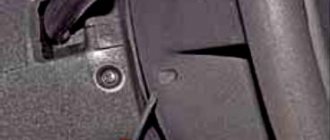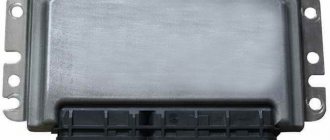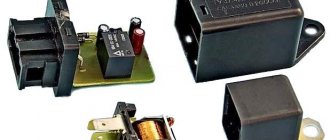03/03/2022 9,676 Sensors
Author: Ivan Baranov
Airbags (Airbags) are an integral element of the safety system of any modern vehicle. Therefore, in order to protect themselves and passengers while driving, the driver must always monitor the performance of this system. What functions does the airbag sensor perform and how to determine a malfunction in the system - find out from this material.
[Hide]
Requirements for PD
Airbags installed in a vehicle must meet the following minimum requirements:
- Must be filled with gas composition at a certain speed.
- Gas must also leave the PD at a certain speed.
- The pillow must have a volume that ensures the safety of the passenger.
- The device must be of the required shape and geometry.
- Correct placement of airbags in the car interior.
- Inflating the pillows at certain moments.
Required Items
Car airbags are a combination of the following elements:
- Pillow shell.
- The gas composition with which it is filled.
- Gas-forming substances.
- Side airbag crash sensor G179.
- Car seat position sensor.
- Driver side airbag crash sensor G179.
- Seat occupancy sensor.
- PB impact sensors located along the windshield, etc.
- Electronic control unit for this security system.
Principle of operation
Knowing the design and functioning of all components, it is not difficult to understand the principle of operation of the airbag: in the event of a collision, sensors detect the impact and send a signal to the control unit. This, in turn, redirects the impulse to the desired gas generator. At the same time, the unit determines the presence of a passenger and decides whether to use the passenger airbag, and also activates the pretensioner squibs (if any) and turns on the window lowering mechanism (if equipped).
The signal received from the unit to the gas generator triggers the squib and the chemical charge ignites. The released gas enters the bag, it unfolds and then immediately descends thanks to the perforation.
Audi A3 SRS system diagram
Note that the main disadvantage of pillows is their disposability. That is, they only work once, after which they need to be changed. And replacement is very expensive, so car owners of cars on which they have worked use a “trick” so that the system is properly diagnosed when the engine starts and is not bothered by a constantly burning warning light.
Varieties
Airbag crash sensors are not the only sensors in the SRS system. It is assumed that they work systematically together with other elements. Here the following stands out:
- Airbag crash sensor.
- Sensor for the presence of passengers in the vehicle.
- Satellite sensor.
Let's get to know them in more detail.
Additional funds
The SRS system device may additionally include a sensor for detecting the presence of a passenger and an emergency lowering mechanism for door windows. The control unit can also control the operation of belt pretensioners (with squibs).
A passenger detection sensor is needed so that the control unit does not activate the front passenger airbag if there is no one in the side seat. Previously, turning off this airbag was done manually, which was not entirely convenient. Installing the sensor solved the problem with the passenger airbag being forgotten on or off.
Passenger seat arrangement
The emergency window lowering mechanism is designed to eliminate pneumatic shock. When the windows are closed, the deployment of the pillows leads to a rapid decrease in the volume of the cabin (it is filled with bags). As a result, the air pressure in the cabin increases sharply and a pneumatic shock is formed, which is quite powerful and passengers can easily damage their eardrums. The mechanism for emergency lowering of the side windows eliminates the increase in pressure and the occurrence of pneumatic shock.
The seat belts of many cars are now equipped with pretensioners, which provide short-term tension of the belt during an accident, securing the body and eliminating its inertial movement. Moreover, the pretensioners are equipped with squibs, which are triggered by an impulse supplied from the airbag control unit.
Shock sensor
Many car owners are interested in where the airbag impact sensors are located. But not everyone knows their purpose.
It also consists in detecting a collision and transmitting the corresponding impulse to the system control device. The design of such a sensor can be very different. It depends on the model of a particular car.
A common example is an electromechanical controller. Accordingly, in a certain situation it will close its contacts. What happens next? When the contacts close, current begins to flow through them. As a result, this leads to the activation of actuators. They are already initiating the filling of airbags with a special gas composition.
We looked at how the airbag impact sensor works. But we must remember that to initiate his actions, only a strong blow is needed. Only then will the process be started.
In the event that at the time of a road accident there is a disruption in the battery power supply, the power banks will still work - they will be filled with gas. What is the reason for this? The system contains a special capacitor device that can accumulate charge.
Gas generator squib
The melting wire or flame front within the ignition element (primer) energizes the airbag gas generators. In modern designs, the capsule for igniting the gas generator is triggered by alternating current in order to prevent the occurrence of a short circuit in the vehicle's electrical DC power system (malfunction in the electrical wiring). To create alternating current, a capacitor is incorporated into the charging capsule and connected in series to the drive circuit, which charges, discharges, or recharges at approximately 100 kHz.
The gas generator, often called a squib (tablet) with a diameter of 10 cm and a thickness of 1 cm, uses crystals of solid fuel, the combustion of which releases gas that fills, or rather, inflates the pillow. The fuel is usually poisonous sodium azide (NaN3), 45% of the mass of which, when burned, turns into pure nitrogen, and the rest into carbon dioxide (CO2), carbon monoxide (CO), water (H2O) and particulate matter. An electrical impulse ignites the squib or melts the wire and the crystals turn into gas. The signal for triggering the squib is an electrical impulse from shock sensors (acceleration or pressure), arriving directly or through an electronic unit. Although the combustion process occurs quickly, it is not explosive. Combustion occurs in 3 stages: ignition, ignition for the fuse and combustion of the working charge. In a very short time the system develops power up to 60 kW, but no explosion occurs. Fuel combustion and inflation of the airbag with a volume of approximately 50...60 liters for the driver lasts 30...35 ms, the airbag for the passenger with a volume of approximately 100...140 liters is installed in the glove compartment area and inflates in approximately 50 ms. This time is less than the time it takes to blink an eye, which is 100 milliseconds.
To prevent injuries from inflating the driving pillow at a speed of 200...300 km/h towards the chest, modern pillows are inflated in two stages: first by about 70%, and when in contact with the body completely, two-stage gas generators are used for this.
Thanks to the radial straightening of the air bag and the sequential ignition of charges in such gas generators, the load that acts on the driver in an accident is significantly reduced. Depending on the severity and type of accident, the interval between the activation of both squibs can be approximately 5 ms. up to 50 ms. Both charges are always fired to eliminate cases when, after deployment of the airbag, there remains another squib that has not fired.
Sensor location
So where are the airbag crash sensors located? It all depends on the model of a particular car. The most common examples of controller layouts are here:
- Airbag control device.
- Inside the salon.
- In some cases, in the engine compartment of a car.
Where are the airbag crash sensors located? In the case of foreign cars, there is another additional shock sensor - this is to turn off the fuel pump. It often causes problems - in the event of a minor impact, the airbags do not deploy, but at the same time, the car cannot be started until this sensor is activated.
Features of transporting children
Transporting children in a car equipped with airbags is a special driving mode. This is because deployed air bags can cause serious injury or even kill a child who is not wearing a seat belt.
That is why experts were united in developing special requirements for transporting children in a car with air bags.
Firstly, it is recommended to transport children only in a well-secured special seat and only in the back seat. » alt=»»> Secondly, if it is impossible to turn off the front passenger airbag, transporting children under 1 year in the front seat is excluded.
Thirdly, if you are driving with a child in a special seat in the front seat, the latter must be moved as far back as possible.
Passenger presence sensor
Now you know the location of the airbag crash sensors. Let's move on to consider the next variety.
The speed at which the airbag inflates completely depends on the weight of the person sitting in the car seat. Its regulation in the event of a car collision is necessary to quickly and timely create a gas layer between the passenger and the center console (in the event of a frontal collision). If the collision is lateral, then the system needs to create a gas layer between the door and the glass.
To carry out these functions, the safety system is primarily based on the weight of the passenger. The impact force is determined by taking into account the elasticity of the airbags themselves.
As for passenger presence sensors, they are located in all cars directly under the seats.
Electronic monitoring and control device
Most current designs use an electronic unit that is installed in the passenger compartment to coordinate the operation of protection systems. The ECU's deceleration calculations are based on data from acceleration sensors used to monitor the deceleration forces that accompany a vehicle collision. The central electronic excitation unit must meet the requirements:
- identification of an accident or collision based on data received from an electronic acceleration sensor and a mechanical “safety detector” or from two electronic acceleration sensors (control with “fully electronic recognition” with redundancy circuitry)
- rapid response of control circuits, airbags and seat belt tensioners, based on special-purpose digital trigger algorithms, in response to various types of accidents (frontal collision, offset frontal collision, collision or collision at a certain angle, collision with a support, etc. .)
- stable voltage and power redundancy
- selective activation of the seat belt tensioner in accordance with the controlled state of the belt webbing - buckle assembly
- determining two response thresholds depending on whether the vehicle user actually uses a seat belt (high or low response threshold of the serial diagnostic interface)
Problems with sensors
Sensors for the presence of people in car seats are often a problem for vehicle owners. The most common is a decrease in the sensitivity of their controllers. So, if there is a child in the passenger seat, the system may simply not detect its presence due to its low weight. And this risks the fact that in the event of a collision, the airbags may simply not be filled with gas.
There is also another side to the problem. If the child’s weight is determined incorrectly by such controllers, the system will begin to inflate the SB at a speed that is too high for his weight. This may result in injury to the baby.
What is an "airbag"
The airbag design is quite simple. Conventionally, the product can be divided into three components: a bag, shock sensors and a gas generator (inflating system).
Bag
It is a thin, multilayer nylon shell (no more than 0.4 mm thick) capable of withstanding large short-term loads. The bag is located in a special tire, which is covered with a special lining made of fabric or plastic.
Shock sensors
These components are typically located at the front of the machine. They are responsible for the timely deployment of the car's airbag, that is, it is these sensors that activate it immediately after a collision with an object at a speed of more than 20 km/h. However, the force of the impact is also taken into account, so the airbag can work even in a stationary car if the collision was strong enough.
Sensors are installed in two types:
- Impact (records the impact that falls on the body).
- Passenger seat sensors (thanks to them, it is possible to exclude the system from triggering if there is no one else in the car besides the driver).
In addition to sensors, accelerometers are also often additionally installed in the system (they help determine the position of the car).
Gas generator
Initially, these elements were equipped with only one squib, which made it very difficult to regulate the gas supply to the airbag based on the size and position of the person sitting in the car. However, modern airbags have 2 squibs. The first (main) releases 80% of the gas (the so-called soft landing), the second is activated only if the collision was too strong and the person needs a harder cushion.
Violation of the integrity of the PB
Car owners should be aware of how to test the airbag crash sensor. After all, the safety of their lives depends on its serviceability.
In most cases, the system itself “tells” the car owner that something is wrong with it. The Airbag or SRS indicator lights up on the dashboard. The most common cause of this problem is a violation of the integrity of the PB.
Because of this, the control device no longer receives impulses from shock sensors, other controllers, seat belts and other system components. In some cars, the seat belts themselves are equipped with sensors that can detect whether they are fastened or not. Therefore, if the driver or passenger forgets to buckle up, the indicator will also light up, signaling a problem with the system.
The fact is that the operation of the safety belt is relevant in the case when the people in the car are buckled up. Otherwise, if the driver does not fasten his seat belts and gets into a road accident, the PBs will fly out at a speed of 200 km/h. And this is already traumatic for a person. A collision with pillows in this case can be compared to hitting a concrete barrier at a speed of 25 km/h!
Indicator light
A monitoring system can be used to monitor the health of the airbag system. When you turn on the ignition, the control light lights up for about 10 seconds, which should then go out. If the light does not light up, does not go out, or lights up while driving, this indicates a system malfunction.
Research by specialists shows that the risk of death of a pedestrian when hitting the hood of a car moving at a speed of only 40 km/h reaches 100%. To solve this problem, companies are actively working on developing airbags for pedestrians. This protection system includes two airbags - a large one that covers the front part of the car (bumper, radiator grille, headlights and hood edge) and a small one that is located near the windshield, protecting the pedestrian's head. Dangerous approaches to pedestrians and animals are detected by special sensors. These airbags will open immediately before a collision.
Today, airbags are an integral part of the safety system of any vehicle. They are needed to protect both the driver and passengers of the vehicle while driving. Therefore, the car owner needs to periodically check the functionality of this system. In particular, monitor the condition of the airbag impact sensors. We will talk about their features and functions. We will also figure out how to find out that the power supply units are faulty.
Fastening and not fastening seat belts
It must be said that many car manufacturers have taken into account this issue with fastening or not fastening seat belts. The problem was solved simply: in the case when an accident occurs and the people in the car are not fastened, the safety guards simply do not work. Here the system cannot guarantee you any security at all.
There are cases when drivers deliberately deceive the security system by pulling belts behind the backs of seats, installing emulators, but without actually buckling up. Accordingly, the system begins to “think” that people are wearing seat belts and, in the event of an accident, releases the airbag at maximum speed.
Such tricks are dangerous. Yes, you will ensure that the indicator on the panel stops lighting if the seat belts are not fastened. But in case of an accident, in this case, you will significantly reduce the chances of survival - both for yourself and for your passengers.
Airbag system indicator on the control panel
One of the indications on the instrument panel in the form of a schematic image of a man on a seat with an air bag (in the shape of a ball) or the letters Airbag, SRS shows the status of the safety unit in question. In order for the warning light to turn on, you need to turn the ignition key; if it does not go out, then there is a high probability of a squib failure.
If the indicator does not light up at all, then perhaps the former owner of the car hid the breakdown or absence of an airbag module by making a deception. But we must take into account that sometimes even in these cases the light bulb can work: often the electronics are interfered with in such a way that an imitation of operability is created. Therefore, inspecting the insides and checking the squib with a multimeter should not be neglected.
Other causes of malfunctions and their solutions
Let's analyze the main causes of problems and malfunctions associated with the car's security system, and present ways to solve them:
- Poor connection of elements in the PB electrical circuit or lack of contacts. Another reason for the constant light of the malfunction indicator is poor connection of the system connectors. The solution is to check all contacts, as well as the quality of the connection.
- Failure of the shock controllers is another common reason for the lights on the dashboard. Perhaps they are not connected well. Check not only the quality of the connection of network elements, but also the connectors. What to do if all contacts are working? If the indicator on the dashboard continues to indicate a malfunction of the shock sensors, it means that these devices need to be replaced as soon as possible. Otherwise, the presence of PBs in your car can be considered useless - they will not react to an impact. How to check the airbag sensor with a multimeter is described in the instructions for the device.
- The next common cause of car security system malfunction is faulty contact in the doors. In most cases, this is a consequence of repair work or replacement of car doors. During this, as a rule, the connectors are disconnected. Therefore, the next time they are connected, all contacts must be checked. If the indicator in this case continues to light even after reconnection, then there is only one way out of the situation - to reset the memory of the security system control device.
- Another cause of malfunction is moisture ingress. It may end up on the contacts of electrical components or on seat belt buckles. This leads to either poor contact or even a short circuit. What to do with such a problem? The place where you find moisture must be thoroughly dried.
- Incorrect functioning of the control unit, its failure. The reason may be simple - the contacts have moved away. But if the essence of the malfunction lies in the device’s board, then the problem can be solved radically - by replacing this unit.
- Safety elements. If such devices fail, the indicator on the dashboard will also light up. The problem is quite common, since not many car owners pay due attention to fuses.
- Replacement of control panel or car seats. This can also lead to a malfunction of the machine's security system. The reason is that when replacing, the integrity of the electrical wiring may be damaged. In particular, connection points may be affected.
- In some cases, a similar malfunction also occurs when replacing the steering wheel. In particular, in cases where during such repairs the contacts of the security system are damaged. At this point, the security system malfunction indicator will light up without ceasing.
- If the airbags were deployed during a road accident, the airbag malfunction indicator in some cases continues to light even after the airbags have been restored. This indicates that information about the incident remains in the memory of the control unit. You can solve the situation by removing this error from there.
- The service life of the airbags is also the reason for the activation of the malfunction indicator. Remember that the average service life of a PB is 8-10 years. If it is exceeded, manufacturers of such systems cannot guarantee the performance of their products.
- Low voltage in the on-board vehicle network. How to solve a problem? First of all, check the battery, and then the generator.
Thus, the shock sensor is an integral part of the safety system. If it malfunctions, the PB will not open at the right time. Therefore, car owners should periodically check its performance. As well as the proper functioning of all other elements of this system. After all, the safety of the life of the driver and passengers of the vehicle depends on it.
How to check a car before buying
You can check the car's history before purchasing using online services. For example, through the all-Russian Internet service “Autocode”. Here you can get information in 5 minutes about whether the vehicle you are interested in was involved in an accident or not. If the car has been in a serious accident, it means that the safety devices have already been activated. But they replaced them with new ones or installed a dummy - it’s up to the potential buyer to check.
To become the owner of information about road accidents in which the car was involved, enter the VIN or state registration number. vehicle number in the search form on the main page of the Autocode website. Within five minutes you will receive information about the type and date of the traffic accident. In addition, the diagram will indicate the location of the most significant damage to the body.
In addition, a detailed report contains information about the former owners of the car, the history of registration actions, the actual mileage of the car, the dates of technical inspections, information about the presence of traffic police restrictions and other useful information about the vehicle.
To be completely sure of the desired swallow, you should inspect it for any technical problems. However, if you do not have enough experience, or you are in another city, an auto expert will do it for you! To do this, just leave a request for an on-site inspection service on the Autocode website.











